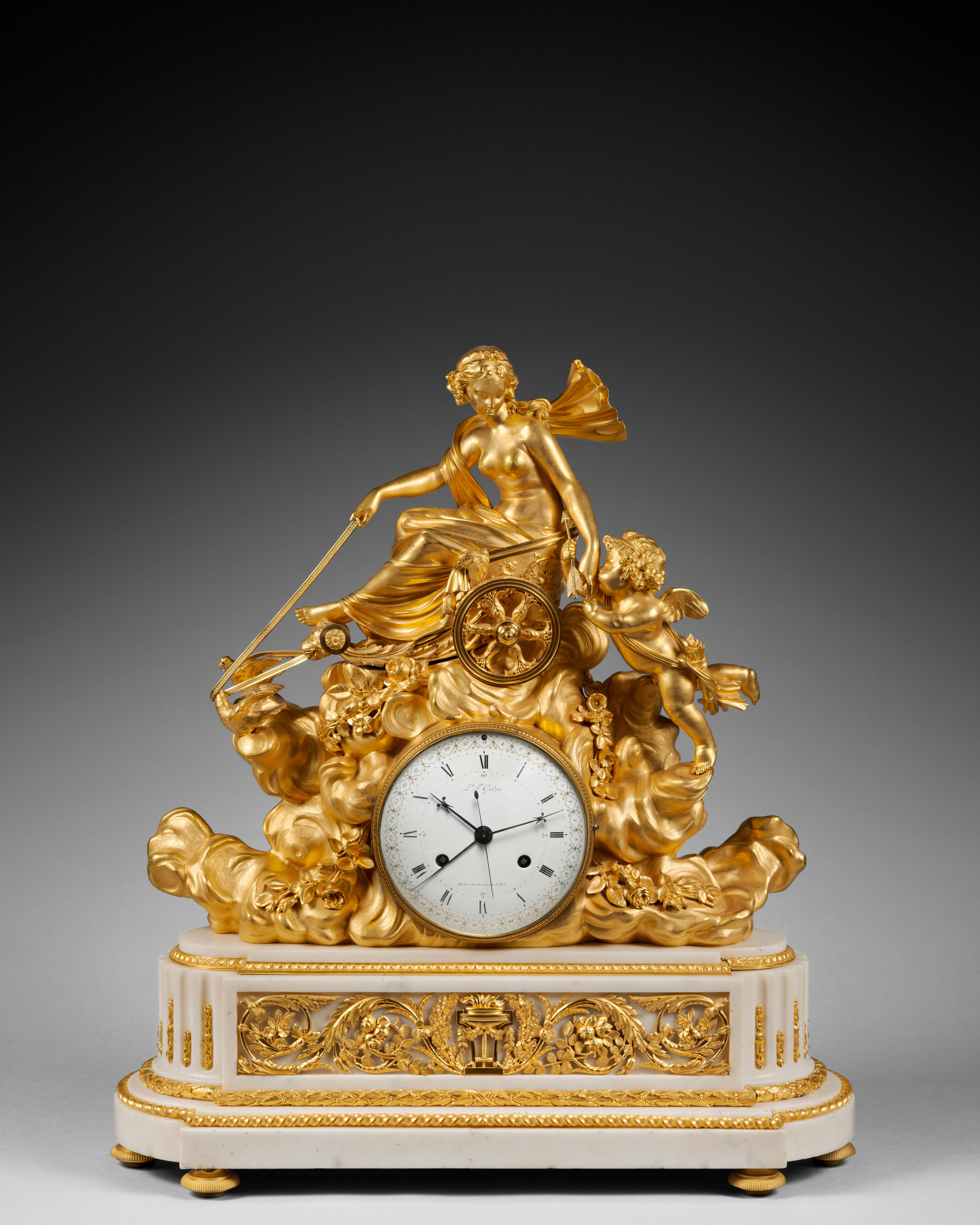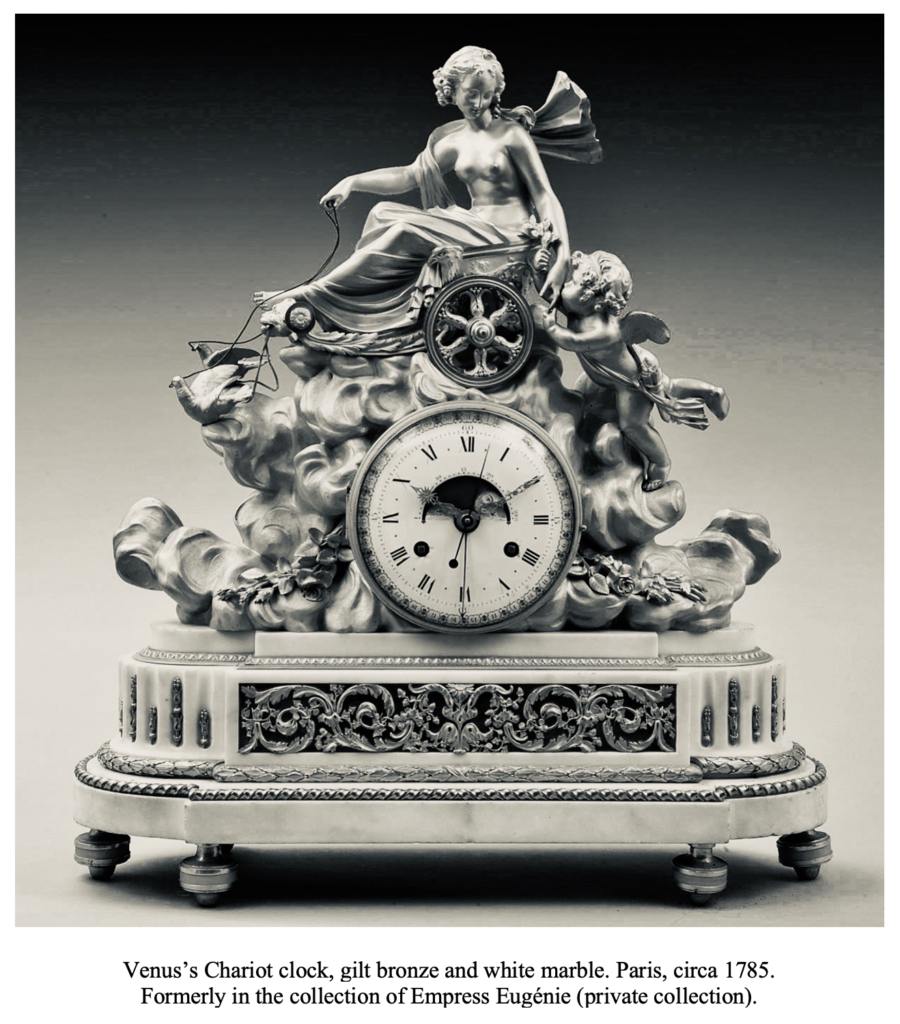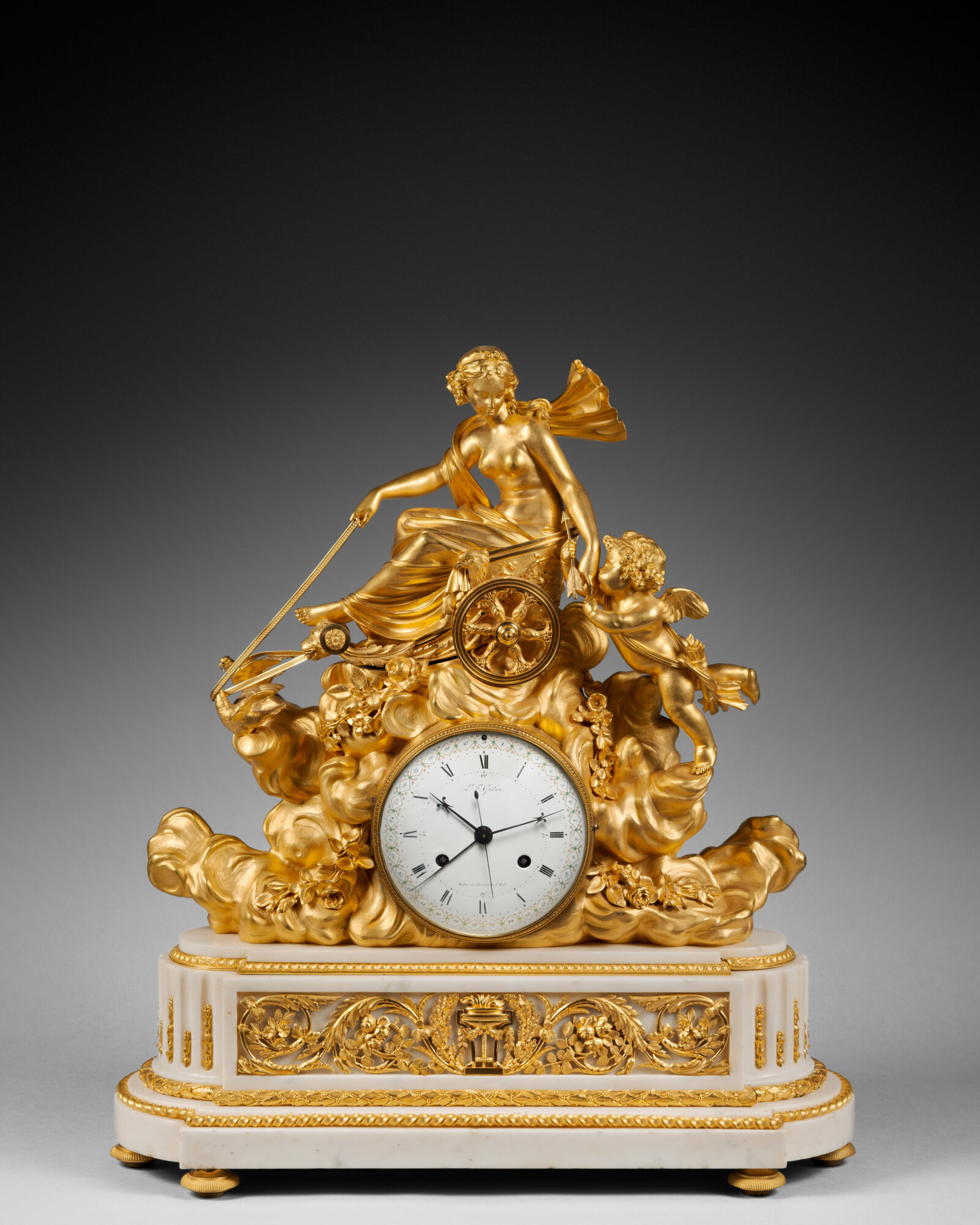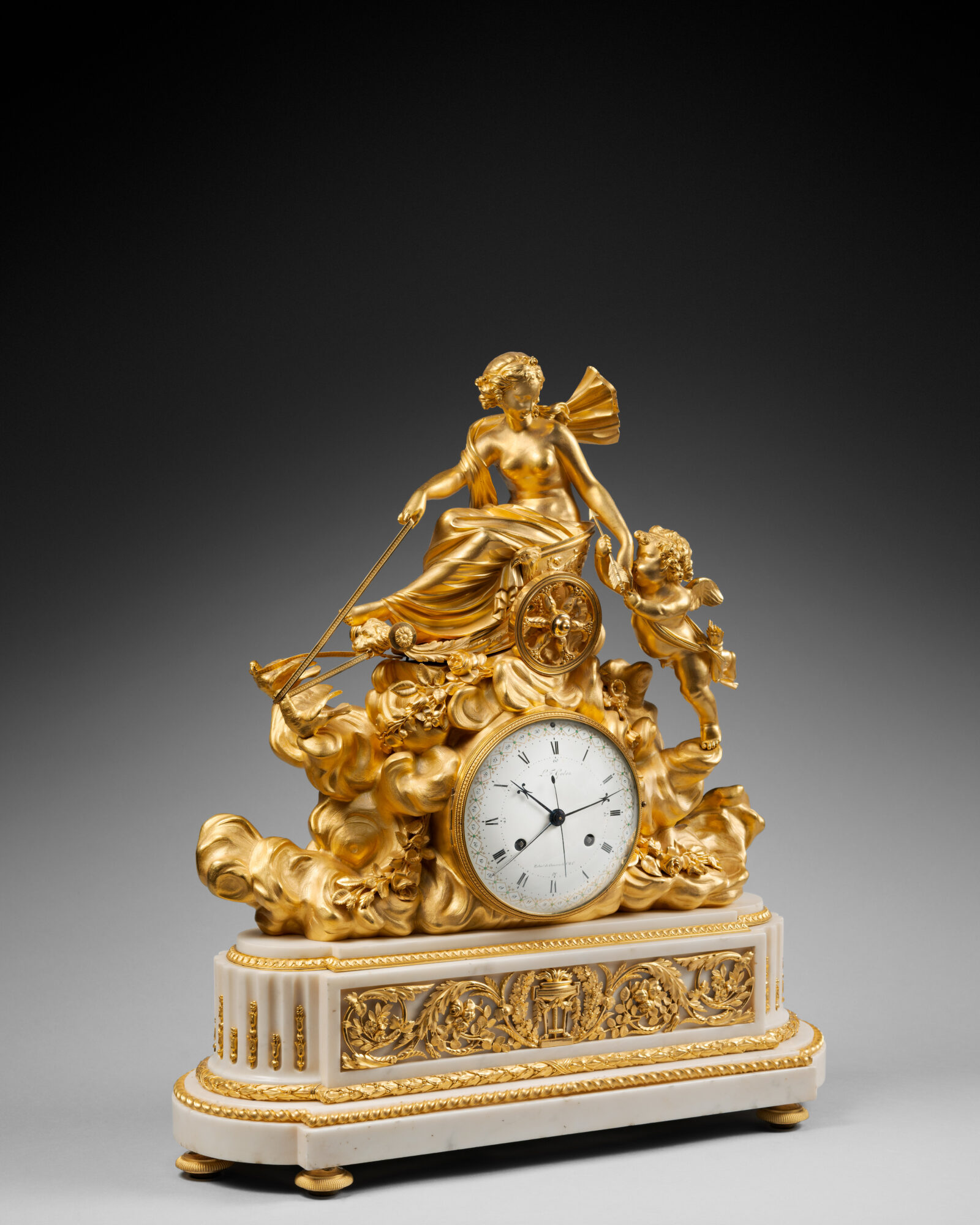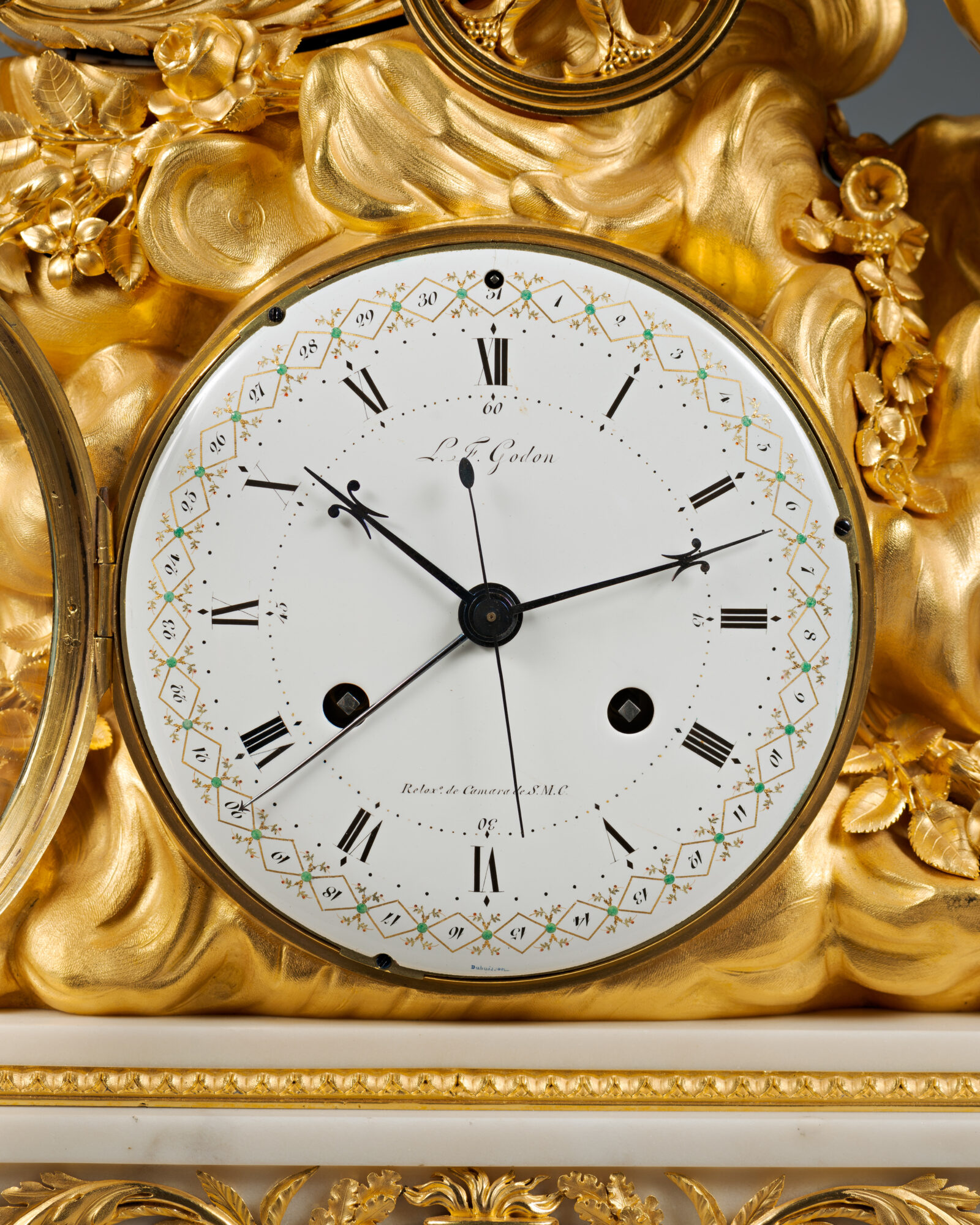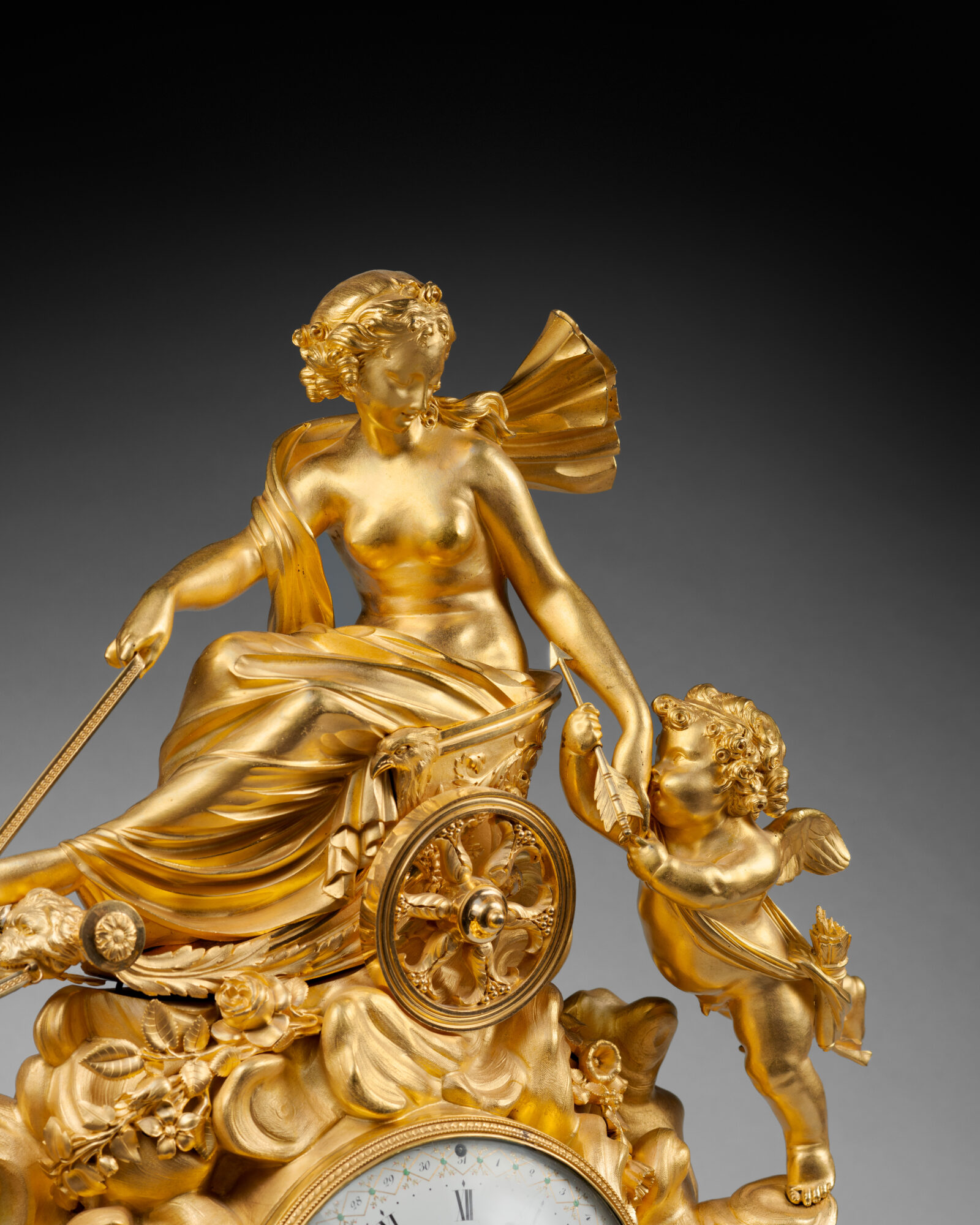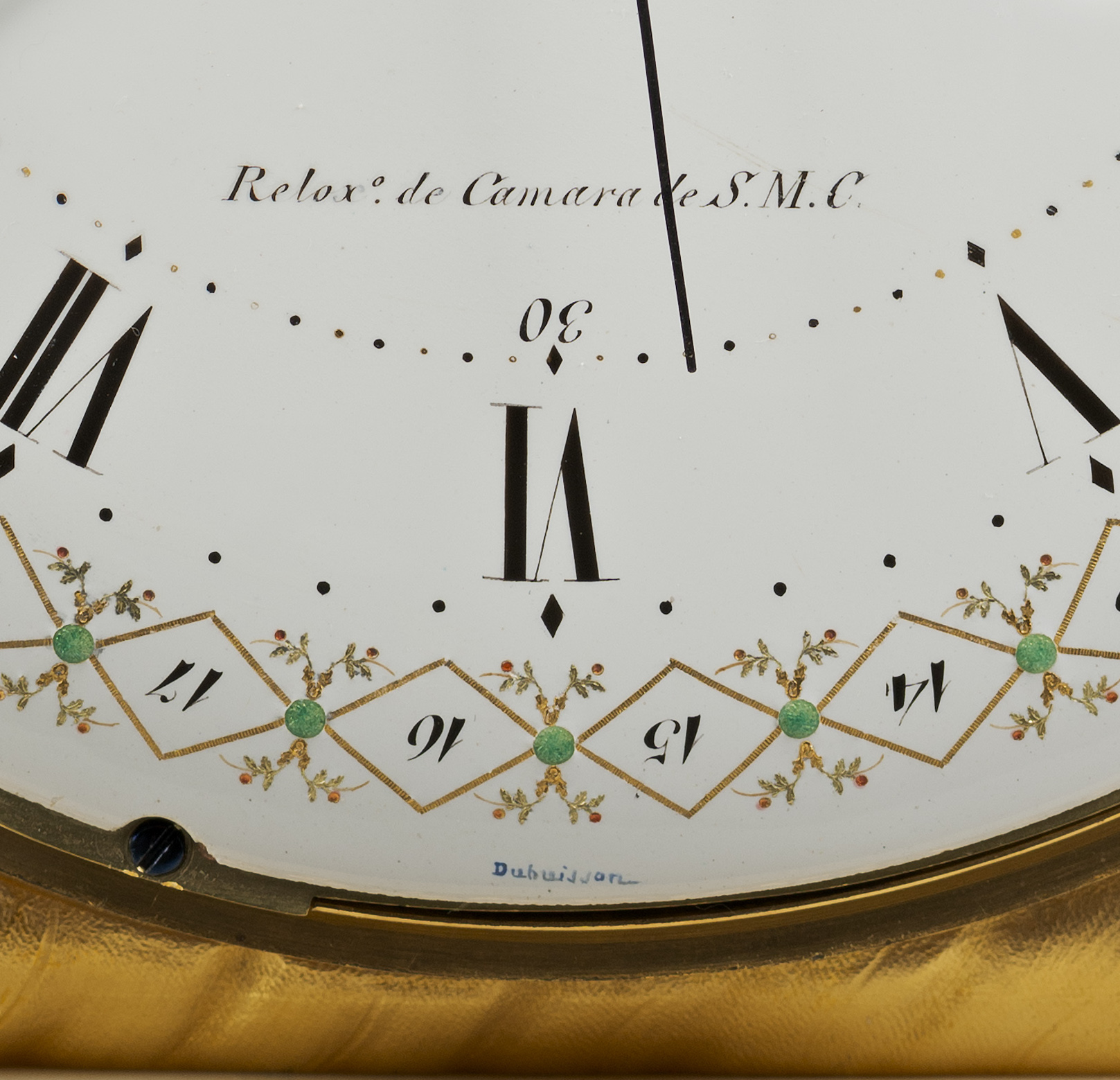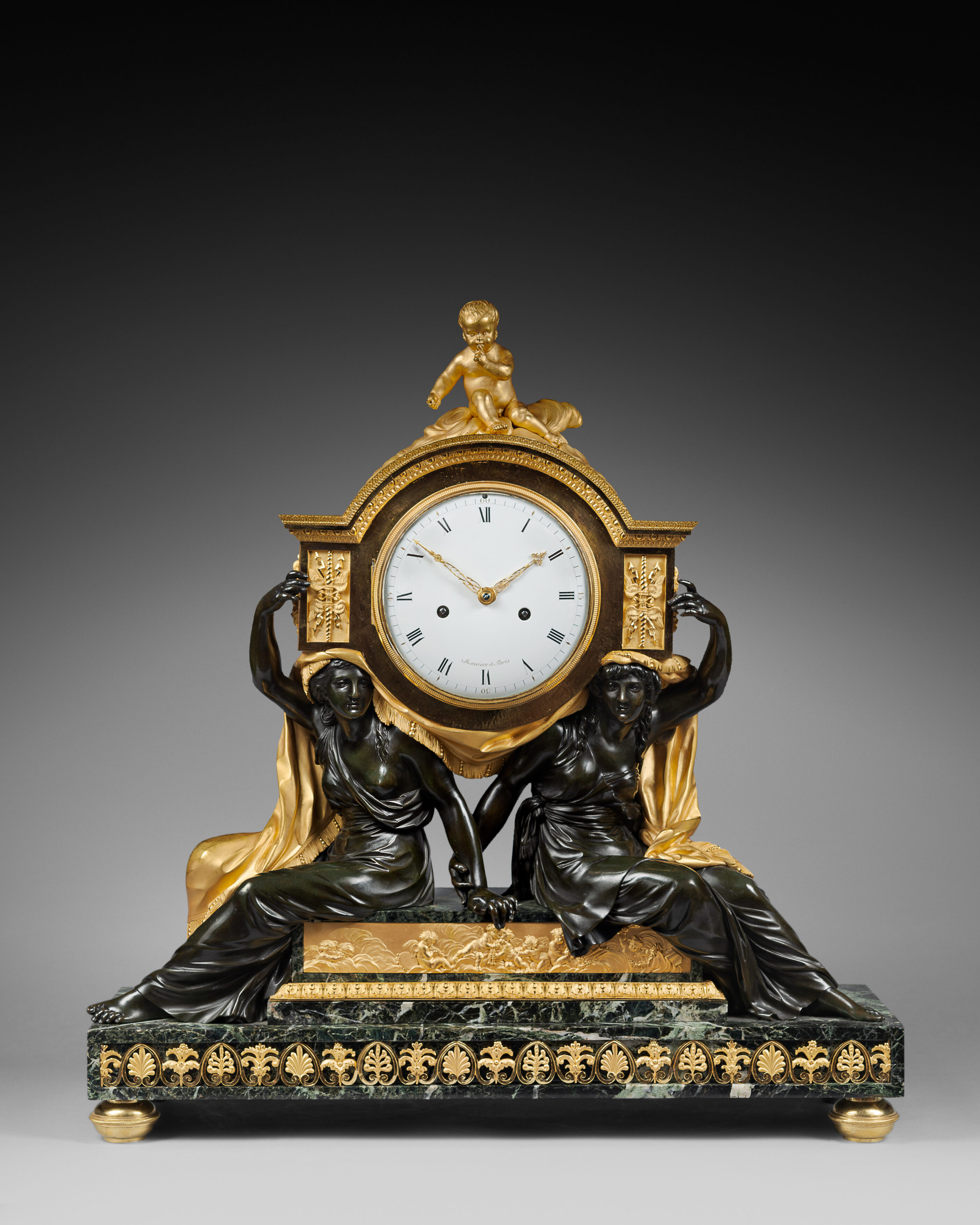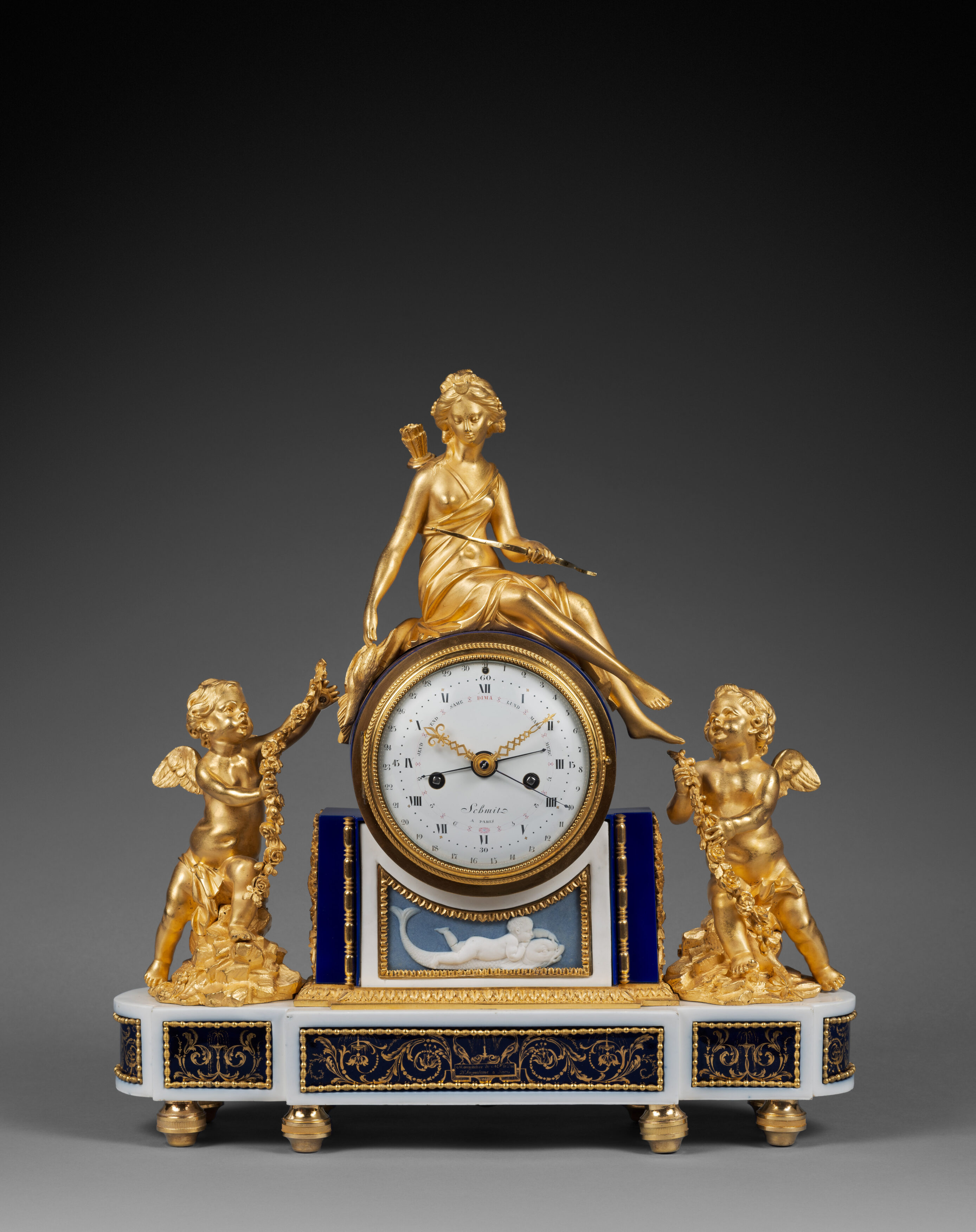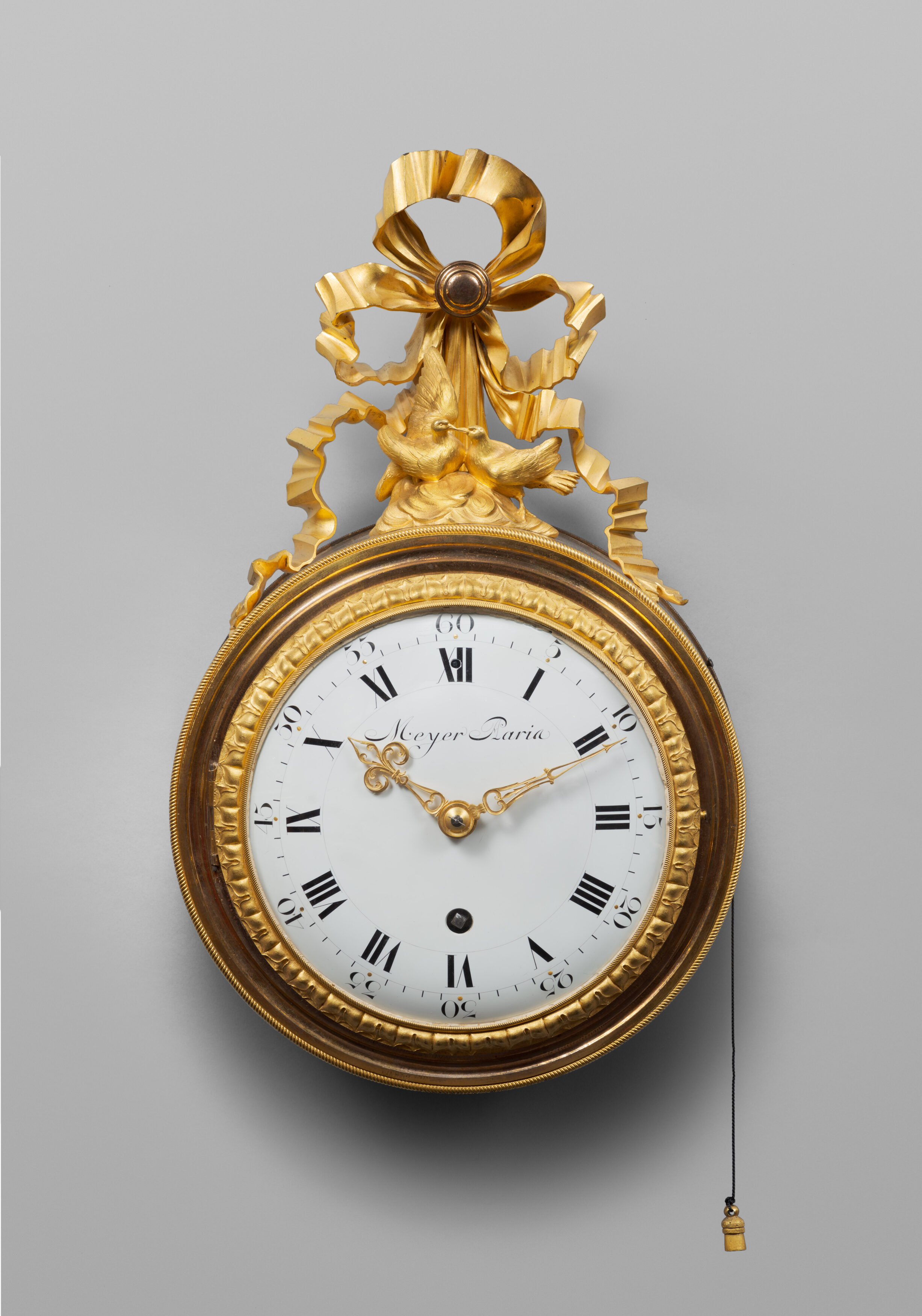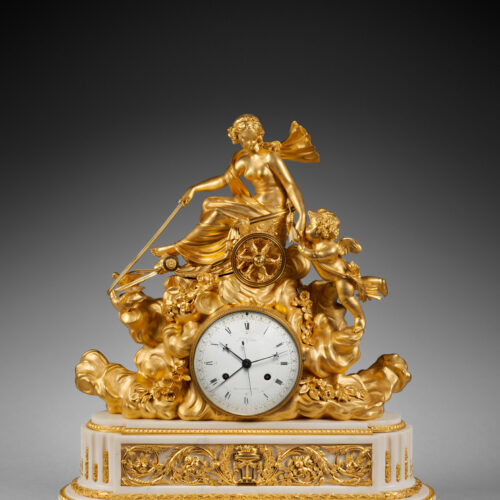Important White Carrara Marble and Gilt Bronze Mantel Clock with Matte and Burnished Finishing
“Venus’s Chariot”
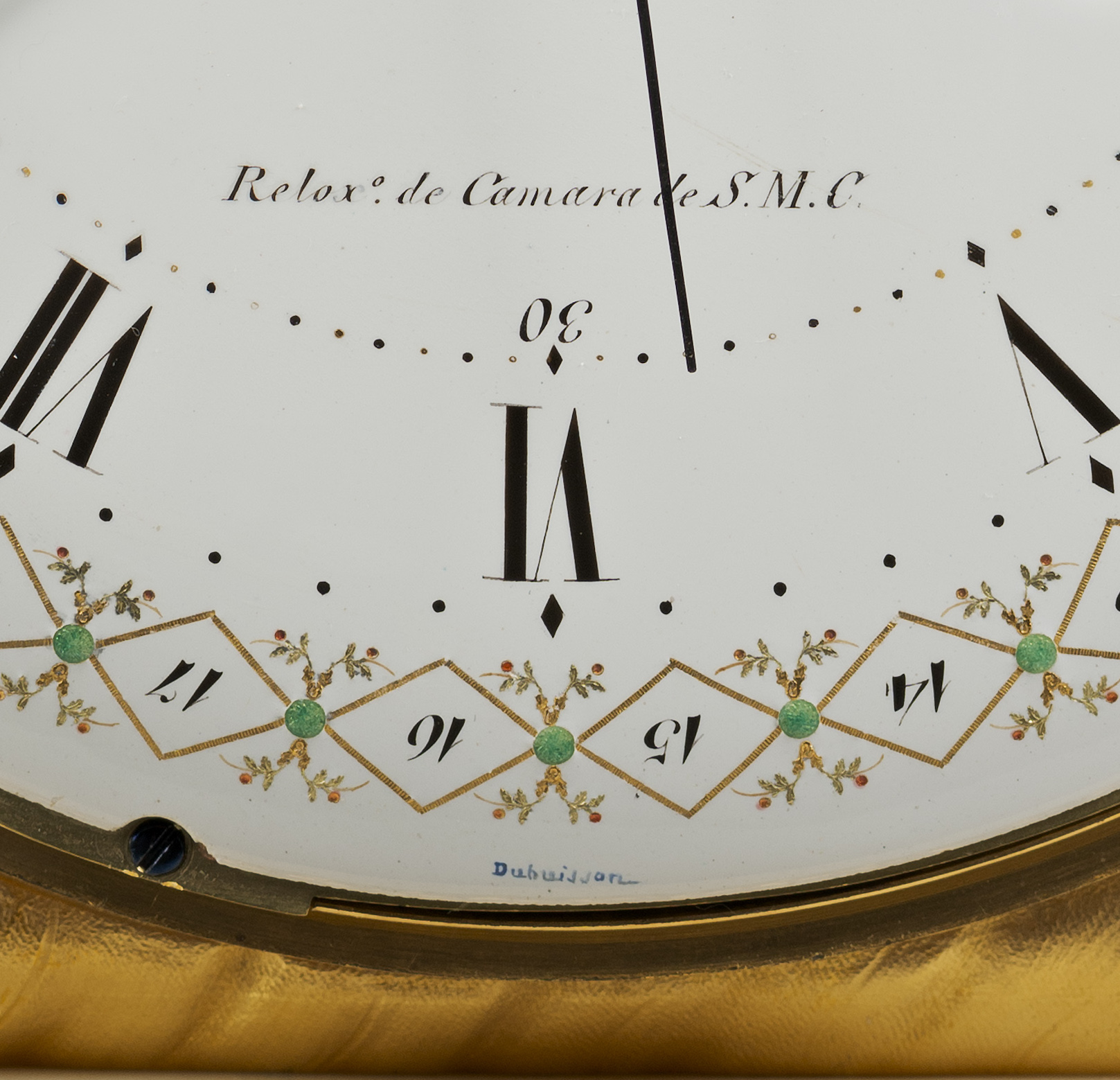
Dial signed « L.F. Godon/Relox de Camara de S.M.C »
Enamel dial by Etienne Gobin, known as Dubuisson
Case attributed to François Rémond
Paris, Louis XVI period, circa 1785
The round white enamel dial is signed “L.F. Godon/Relox de Camara de S.M.C” and is adorned with a zigzag pattern embellished with translucent green cabochons and delicate flowering branches with leaves. Under the 6th hour, it bears the signature “Dubuisson” of enameller Etienne Gobin, known as Dubuisson, who was one of the most renowned Parisian enamellers of the time, and a colleague and rival of Joseph Coteau. It indicates the Roman numeral hours, the fifteen-minute intervals, and the Arabic numeral date by means of three blued steel hands; there is a central seconds hand. The hour and half-hour striking movement is housed in a magnificent gilt bronze case adorned with mythological figures, which is finely chased and matte gilt. The clock is surmounted by the figure of the goddess Venus, who is partially nude and lightly draped. She is riding in a chariot that is drawn by two doves which are resting on clouds that are adorned with branches of roses, with the figure of Cupid with a quiver slung across his chest. He is reaching toward the goddess, to give her an arrow. The white Carrara marble base is rectangular with rounded corners and is decorated with rudented fluting. It is adorned with a frieze of water leaves, beribboned laurel toruses, and beadwork. The panel on the façade bears a reserve with scrolling, leaves, and flowers. It is centered by a neoclassical athenienne, with a spirally decorated leg and lion’s paw feet, flanked by oak leaves. The six feet are adorned with a knurled band.
Discover our entire collection of antique mantel clocks for sale online or at the gallery.
La Pendulerie is the specialist in fine and rare antique clocks, based in Paris.
In luxury Parisian horology of the second half of the 18th century, it was rare to see models based on the theme of the chariot. The present example stands out due to the exceptional quality of its chasing and gilding, which suggest an attribution to François Rémond, one of the most important Parisian artisans of the latter part of the reign of Louis XVI. It is adorned with Venus and Cupid, figures mythological figures that are also found, with variations, on a less impressive chariot clock whose dial is signed Sotiau that is today in the Metropolitan Museum of Art in New York. A second example was described in the collection of M. Mannheim the elder: “A lovely clock from the Louis XVI period, in finely chased and matte gilt bronze; Venus is seated in a chariot drawn by two doves; it is followed by Love. The base is decorated with a fine frieze of putti. Movement by Berthoud, in Paris. Height 42 cent.” (Maître Delbergue-Cormont, Hôtel Drouot, December 23, 1867, lot 143). A third example, whose dial is signed “Robin” and which features Venus giving an arrow to Cupid, is today in the Musée National du Château de Versailles.
The clock that is today in Versailles might be the one that was described at the time of the Revolution, in 1793, in “L’Etat de l’horlogerie de la ci-devant Reine entretenue par Robin horloger aux galleries du Louvre n° 8”: (a description of the former queen’s horological pieces, maintained by the clockmaker Robin, galleries du Louvre n°8”) “A clock composed of a white marble base, adorned with a bas-relief, on which stands the chariot of Venus drawn by two doves, a small putto next to the chariot is presenting an arrow to the goddess, all made of gilt bronze with matte finishing, bearing the name of Robin (Fontainebleau, chez M. Robin)” (see P. Verlet, Les bronzes dorés français du XVIIIe siècle, Editions Picard, Paris, 1999, p. 466). Nevertheless, one quickly sees the differences between the clock today in Versailles and the clock owned by Marie-Antoinette, particularly in that Cupid is presenting an arrow to the goddess and not the contrary. A clock that is identical to the present example, and whose dial is signed by the enameller “Merlet”, was purchased in 1864 by the Mobilier National; it later stood in the petit salon of the Villa Eugénie in Biarritz, which belonged to the empress. It was sold in 1927 in England when the collection of Empress Eugenie, the wife of Emperor Napoléon III, was sold. The Empress’s clock featured a Cupid that was giving a branch to Venus, rather than an arrow as in the example that belonged to Queen Marie-Antoinette.
François-Louis Godon (circa 1740 - 1800)
François-Louis Godon became a master clockmaker in Paris in February 1787, although he had begun working several years previously. Having gone into partnership as early as 1785 with his Parisian colleague Jean-Baptiste-André Furet, Godon is known for having been a trusted horological supplier to kings Charles III (Carlos III) and Charles IV (Carlos IV) of Spain. In March 1786, having been named “Relojero de Camara de Su Majestad Católica” (Clockmaker to the King of Spain), he became the Parisian supplier of luxury porcelain pieces, clocks, and bronze furnishings to the Spanish Court. Today many of his clocks are in the Madrid Decorative Arts Museum and the Spanish Royal Collections.
François Rémond (circa 1747 - 1812)
Along with Pierre Gouthière, he was one of the most important Parisian chaser-gilders of the last third of the 18th century. He began his apprenticeship in 1763 and became a master chaser-gilder in 1774. His great talent quickly won him a wealthy clientele, including certain members of the Court. Through the marchand-mercier Dominique Daguerre, François Rémond was involved in furnishing the homes of most of the important collectors of the late 18th century, supplying them with exceptional clock cases, firedogs, and candelabra. These elegant and innovative pieces greatly contributed to his fame.
Dubuisson (1731 - after 1820)
Etienne Gobin, known as Dubuisson, was one of the most talented Parisian enamellers of the reign of Louis XVI and the Empire period. Born in Luneville in 1731, he began his career as a painter on porcelain in Strasbourg and Chantilly. He then moved to Paris and worked at the Royal Sèvres porcelain manufactory from 1756 to 1759, specializing in the decoration of watch cases and clock dials. In the 1790s, his workshop is mentioned as being in the rue de la Huchette, then the rue de la Calandre around 1812. He appears to have retired in the early 1820s. He mostly signed his work “Dubuisson” or “Dub”, sometimes “Dubui”. Having worked with the most renowned clockmakers of his time, including Robert Robin, Kinable, and the Lepautes, Dubuisson was the main rival of Joseph Coteau. Specializing in watch cases and enamel dials, he was famous for his exceptional talent and his ability to render detail. His body of work, always of the highest quality, is considerable. To mention only a few of his pieces, some clocks bearing his signature are today in Pavlovsk Palace near Saint Petersburg, in the Louvre Museum in Paris, and in the Royal British Collection.
